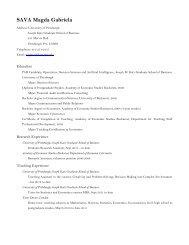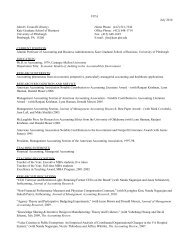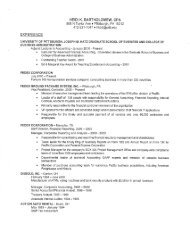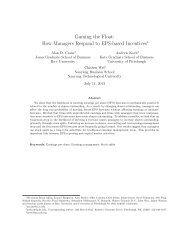Stuart L. Gillan, Jay C. Hartzell, Andrew Koch, and ... - Pitt Business
Stuart L. Gillan, Jay C. Hartzell, Andrew Koch, and ... - Pitt Business
Stuart L. Gillan, Jay C. Hartzell, Andrew Koch, and ... - Pitt Business
Create successful ePaper yourself
Turn your PDF publications into a flip-book with our unique Google optimized e-Paper software.
esults that are consistent with the first two hypotheses of Baron (2008) <strong>and</strong> Benabou <strong>and</strong> Tirole<br />
(2010) <strong>and</strong> the central empirical implication of Besley <strong>and</strong> Ghatak (2007). The coefficient on net<br />
Environmental score indicates that, holding environmental concerns constant, each additional<br />
environmental strength is associated with an additional 0.77% return on assets. The relationship<br />
between the net Governance score <strong>and</strong> operating performance is also economically significant.<br />
A one unit increase in net Governance is associated with an additional 1.15% return on assets.<br />
For comparison, the unconditional average return on assets in our sample is 6.94%. We hesitate<br />
to draw strong conclusions from these tests alone, however, as it could be the case that more<br />
profitable firms can “afford” to adopt policies that are viewed more favorably, or that revenue is<br />
increasing in such policies, or that costs are decreasing (e.g., due to lower wages at such firms).<br />
Motivation for ESG<br />
In order to provide further insights into how ESG might be linked to operating<br />
performance, <strong>and</strong> to further examine motivations for firms to engage in adopt stronger ESG<br />
policies, we decompose operating performance into revenues <strong>and</strong> expenses. In particular, in<br />
Table III, we employ an approach similar to that of Table II, <strong>and</strong> report results modeling the link<br />
between 1) Revenue/Assets <strong>and</strong> then 2) Operating Expenses/Assets <strong>and</strong> net E, S, <strong>and</strong> G scores<br />
(along with control variables). For completeness <strong>and</strong> ease of comparison, we also include the<br />
relevant specification from Table II.<br />
In Panel A of Table III we focus on the net environmental score, while in Panels B <strong>and</strong><br />
C, we focus on the net Social <strong>and</strong> Governance scores, respectively. In Models 1, 3, <strong>and</strong> 5 of each<br />
panel we report results for base specifications modeling dependent variables Revenue/Assets,<br />
Operating Expenses/Assets, <strong>and</strong> EBIT/Assets (the latter as reported in Table II) as a function of<br />
12













